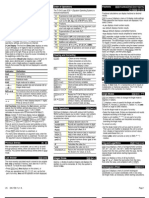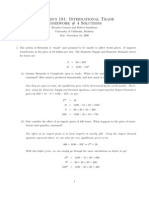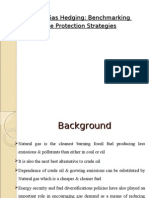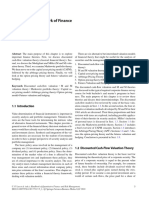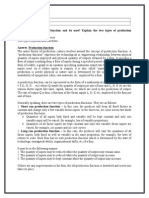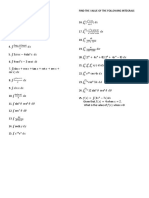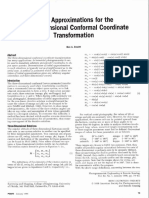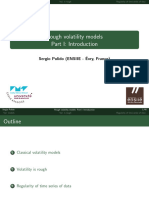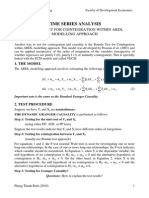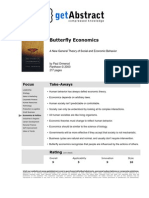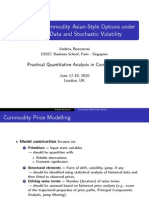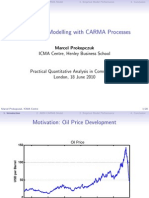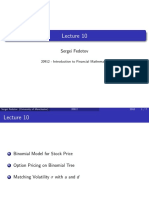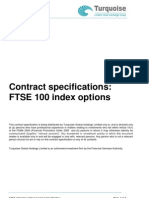Emmanuel Gincberg
Emmanuel Gincberg
Uploaded by
LameuneCopyright:
Available Formats
Emmanuel Gincberg
Emmanuel Gincberg
Uploaded by
LameuneOriginal Description:
Copyright
Available Formats
Share this document
Did you find this document useful?
Is this content inappropriate?
Copyright:
Available Formats
Emmanuel Gincberg
Emmanuel Gincberg
Uploaded by
LameuneCopyright:
Available Formats
MINI CASE STUDY SERIES:
TWO FACTORS MODEL CALIBRATION
Emmanuel Gincberg
CREDIT AGRICOLE CIB. Head of Commodity Quantitative Analytics.
The views expressed in this document are those of the author and do not necessarily
represent those of his employer.
Marcus Evans. Practical Quantitative Analysis in Com-
modities. 17th June 2010
MODELLING THE FUTURE CURVE
2
MODELLING THE FUTURE CURVE
3 MODELLING THE FUTURE CURVE
MODELLING THE FUTURE CURVE
The most activated traded instruments in commodity financial markets
are future and forward contracts.
NYMEX and ICE exchange markets enable to trade future con-
tracts up to 72 consecutive months for many energy assets.
Agricultural futures can be traded on the CBOT exchange.
Forward agreements are OTC contracts which generally settle on
monthly average of future closing prices.
Commodity Swaps are transactions where the floating price is
indexed on future prices.
4 MODELLING THE FUTURE CURVE
MODELLING THE FUTURE CURVE
Many commodity derivatives depend on different future contracts
(Swaptions, time spreads,).
It is therefore important to not only correctly model each future
contract but also to correctly represent the joint distribution of these
assets.
To do so it is convenient to consider the future curve as a whole
rather than a collection of individual points
5 MODELLING THE FUTURE CURVE
BACKWARDED FUTURE CURVE
6 MODELLING THE FUTURE CURVE
CONTANGO FUTURE CURVE
7 MODELLING THE FUTURE CURVE
BACKWARDATION TO CONTANGO
8 MODELLING THE FUTURE CURVE
FUTURE CURVE VARIATIONS
This particular observation illustrates general behaviours of commodity
future curves:
Commodity prices are governed by supply and demand.
Future curves short ends are generally much more volatile than long
ends (mean reversion).
Short dated future are used to cover unanticipated demand, their
prices are impacted by:
Weather conditions
Pipeline failures
Political events
Etc...
9 MODELLING THE FUTURE CURVE
SHORT TERM / LONG TERM MODEL
Schwartz-Smith proposed a model to describe the variations of the fu-
ture curve where the spot price logarithm is driven by two factors:
ln(
t
) = _
t
+
t
_
t
is the short term process:
_
t
= _
t
+o
t
is the long term equilibrium process:
t
= p
{
+o
{
t
{
[
t
t
{
= p
10 MODELLING THE FUTURE CURVE
SHORT TERM / LONG TERM MODEL
Under these assumptions the future prices are lognormal variables:
ln
|
F(t, T)]
=
-k(1-t)
_
t
+
t
+ ( )
|ln
|
F(t, T)]
] =
-k1
_
0
+
0
+ p
{
+ ( )
vai|ln
|
F(t, T)]
] =
-2k1
(
2kt
1)
c
_
2
2k
+o
{
2
+2
-k1
(
kt
1)
c
_
c
(
k
() is a deterministic function:
() = p
{
+
1
2
(1
-2k1
)
o
2
2
+ o
{
2
+2(1
-k1
)
o
o
{
11 MODELLING THE FUTURE CURVE
SHORT TERM / LONG TERM MODEL
Although, as shown in the Schwartz-Smith paper, this approach is
equivalent to a stochastic convenience model, it is probably more intui-
tive due to the break down between short and long term drivers.
_
t
is a mean reverting process which has more impact on short
dated maturities.
t
creates parallel shifts of the curve
Short dated futures tend to revert to the long run equilibrium
regime which is driven by
t
These variables are however not observable
12 MODELLING THE FUTURE CURVE
FUTURE CURVE MODEL
The previous approach consists in defining the spot price driving vari-
ables and to deduce the corresponding future prices dynamic. Alterna-
tively we can directly model the future price:
uF(t, T) = F(t, T)
I
(t, T) uW
t
I
I
The short term / long term model corresponds to a specific formula-
tion of the volatility functions
I
(t, T) where the number of factors is
set to 2.
In a more general setting the number of Brownian processes W
t
I
can
be reduced by PCA techniques.
MODELLING THE FUTURE CURVE 13
FUTURE CURVE MODEL
A more generic formulation of the short term long term future curve
model can therefore be expressed as follows:
F(t, T
I
) = F(u, T
I
) exp _
1
2
i
(t, T)
2
+
-k(T
-t)
_
t
+
t
_
Where
F(u, T
I
) is the current price of the future contract expiring at T
I
.
_
t
=
-kt
]
ku
o
()
u
t
0
t
= ] o
{
()
u
{
t
0
[
t
t
{
= p
I
(t, T) =
_
-2kT
]
2ku
o
()
2
+
t
0
] o
{
()
2
+
t
0
-kT
]
ku
o
()o
{
()
t
0
14 CALIBRATION
CALIBRATION
15 CALIBRATION
KALMAN FILTER
In their original papers Gibson-Schwartz and Schwartz-Smith propose to
estimate the model parameters with a Kalman filtering technique.
The kalman filter is a recursive method for estimating non observable
variables from observable variables.
Kalman results can be statically unstable.
There is no guarantee that this procedure would produce a set of pa-
rameters consistent with implied volatilities.
The model should be in line with the term structure of volatilities if we
want to use the corresponding options for hedging.
16 CALIBRATION
LISTED OPTIONS
Similarly to the future market there exists a listed commodity market
for options: For each future contract there generally exist Call and Put
options expiring shortly before the corresponding future maturity .
These options are the basic instruments of choice for the
hegdge of Vega risks linked to more complex derivatives
They imply a term structure of implied volatilities but contrary
to other markets the underlying is different for each maturity:
In Equity markets a term strucure of volatility defines a
strip of option prices on the same asset observed at
different times.
In most commodity markets each volatility point
corresponds to a unique future underlying expiry.
CALIBRATION 17
TERM STRUCTURE OF VOLATILITY
A term structure of volatility represents the variation of volatility with
maturity.
It is common to represent the at-the-money volatilities to illustrate
the term structure.
Commodity term structures tend to be downward sloping. It can be
explained by the mean reverting nature of these markets.
Each volatility point of the term structure corresponds to a unique
future contract point
18 CALIBRATION
TERM STRUCTURE OF VOLATILITY
19 CALIBRATION
TERM STRUCTURE OF VOLATILITY
Although volatility term structure varies with time, the downward slop-
ing profile is a persistent characteristic of volatility term structures.
By time homogeneity we can deduce that the volatility term struc-
ture of a fixed future contract should be upward sloping
(Samuelson effect).
This is consistent with the short term/long term model:
vai ln|F(t, T)] =
2
(
2
1)
o
_
2
2
+2
1)
o
_
o
+o
2
The first two terms are bounded as t & T tends to infinity
i.e. the corresponding volatility is decreasing towards 0.
When T is fixed the first two terms are increasing with t.
20 CALIBRATION
VOLATILITY TERM STRUCTURE CALIBRATION
But calibration to ATM volatilities will not provide a unique solution.
= 116%,
= 11u%,
= 2S%, = 88%
21 CALIBRATION
VOLATILITY TERM STRUCTURE CALIBRATION
Another satisfactory calibration:
= 22S%,
= 9u%,
= 18%, = 2u%
CALIBRATION 22
VOLATILITY TERM STRUCTURE CALIBRATION
The previous calibrations are obtained by global minimization of the
differences between listed options implied volatilities and the corre-
sponding volatilities computed with the two factors model parame-
ters (with constant instantaneous volatilities
and
{
).
Another approach consists in extrapolating
{
from the term struc-
ture of volatility as it corresponds to the implied volatility limit
(
_
Var|In|F(t,T)]]
t
) when (t, T) tend toward infinity:
Each point of the ATM volatility term structure can then be
exactly matched by introducing piecewise-constant instanta-
neous volatilities o
().
However there is no unique solution: each couple (, ) will
lead to a different o
() profile.
CALIBRATION 23
VOLATILITY TERM STRUCTURE CALIBRATION
In order to illustrate the previous calibration method let us denote by
(t
I
, o
A1M
()) the market option maturities and corresponding ATM implied
volatilities (to simplify the calculations we assume p = u).
If we suppose that (, ) are known it remains to define o
() = o
() for
]
,
+1
] such as
-2kT
]
2ku
o
()
2
+
t
i
0
o
{
2
=
I
2
= 1
It implies the following result:
o
()
2
=
(o
A1M
()
2
o
{
2
)
2k(T
-T
-1
)
(o
A1M
( 1)
2
o
{
2
)
-1
-2kT
2
(
2kt
2kt
-1
)
It can only be solved if
(o
A1M
()
2
o
{
2
)
2k(T
-T
-1
)
(o
A1M
( 1)
2
o
{
2
)
-1
u
CALIBRATION 24
VOLATILITY TERM STRUCTURE CALIBRATION
We have seen that calibrating (, ) to the term structure of volatility can
generate different results:
Two acceptable calibrations can create different correlation profiles
of the future curve.
The volatility term structure profileo(, ) of a given future contract
implied by the model is mainly driven by the mean reversion
level:
o(, ) = _
-2k1
(
2kt
1)
o
2
2
+2
-k1
(
kt
1)
o
o
{
+o
{
2
_
1
2
,
CALIBRATION 25
VOLATILITY TERM STRUCTURE CALIBRATION
Volatility term structure of a fixed contract
CALIBRATION 26
HISTORICAL FUTURE PRICES
When no additional type of option quotes (swaptions, time spread
options) relevant for the calibration of the mean reversion/correlation
are available, an alternative solution is to use historical future prices.
Let us consider historical future prices
{
F(t, t +
I
)]
0<t<M
0<I<N
, where t
represent past observation dates, and
I
are constant expiries (they
are in fact approximated by the average time to maturity of the k-th
nearest future).
We focus on the stochastic term
i
(t) of the corresponding loga-
rithmic returns n _
F(t+t,t+t+
i
)
F(t,t+
i
)
_:
(t) = _
-k(t+t+
-u)
o
t+t
0
_
-k(t+
-u)
o
+
t
0
-kT
_ o
{
u
{
t+tt
t
CALIBRATION 27
HISTORICAL FUTURE PRICES
With a local expansion around t~u, we can write
or|
(t)] = |
-k
]
2
+o
{
2
t +(t
2
)
Up to the first order of t, the stochastic terms of the logarithmic re-
turns are independent and equi-distributed:
(t)~u, |
-k
]
2
+o
{
2
t
Similarly we can compute the covariances c
]
(, o
, o
{
) corresponding
to two different contracts:
c
]
(, o
, o
{
) = _
-k(
+
]
)
o
2
+o
{
2
] t
The calibration method consists in minimizing the differences between
the model and the historical covariances.
CALIBRATION 28
HISTORICAL FUTURE PRICES
= 84%,
= 17%,
{
= 2u%, = 19.S9%
29 CALIBRATION
VOLATILITY SEASONALITY
In some markets, for example Henry Hub natural Gas, the term struc-
ture of volatility is strongly seasonal.
It can be explained by higher demand, and therefore volatility, during
heating periods in winter.
The short term/long term breakdown cannot explain these term struc-
tures, alternative approaches have to be considered.
Each month of the year can be modelled by a distinct underlying creat-
ing twelve different term structure of implied volatilities.
30 CALIBRATION
VOLATILITY SEASONALITY
A typical Natural Gas term structure of ATM volatilities
31 CONCLUDING REMARKS
VOLATILITY SEASONALITY
Natural Gas ATM volatilities with the
August and November months highlighted.
CALIBRATION 32
VOLATILITY SEASONALITY
Each season can be calibrated separately and it remains to define the
correlations between summer and winter:
ln
|
F
Summcr
(t, T)]
=
-k
S
(1-t)
_
t
S
+
t
S
+
S
( )
ln
|
F
WIntcr
(t, T)]
=
-k
W
(1-t)
_
t
w
+
t
w
+
w
( )
The summer-winter correlations can be estimated by historical
analysis or implied from Calendar spread options, the most liquid
pairs being March-April and October-January.
[
t
t
{
W
= p
{
Sw
, [
t
{
s
W
= p
{
Sw
[
t
W
= p
Sw
, [
t
{
s
t
{
W
= p
{
Sw
CALIBRATION 33
HEDGING CONSIDERATIONS
Different calibration methods will imply different hedging strategies.
Let us assume two different approaches where the mean reversion is
calibrated to historical covariances. We want to price a calendar spread
option:
|(
1
,
1
) (
1
,
2
)]
+
Forward model:
uF(t, T
I
) = F(t, T
I
)
I
(t, T
I
) uW
t
I
Each volatility function
I
(t, T
I
) is calibrated separately to the appropri-
ate ATM volatility point.
CALIBRATION 34
HEDGING CONSIDERATIONS
Short term/long term model ( = u):
ln
|
F(t, T
I
)]
= +
-k1
_
ku
t
0
o
(u)
t
+o
{
t
{
o
{
is calibrated to the implied volatility curve asymptote:
vai|ln|F(t, T)]]
t
t,T
---- o
{
2
= o
A1M
2
()
o
() is a piecewise constant function calibrated to the ATM volatility
curve.
-2k1
i
_
2ku
t
i
0
o
2
() +o
A1M
2
()
= o
A1M
2
(i)
2
() =
2k1
i
|o
A1M
2
() o
A1M
2
()]
2k1
i-1
-1
|o
A1M
2
( 1) o
A1M
2
()]
2kt
i
2kt
i-1
2
CALIBRATION 35
HEDGING CONSIDERATIONS
With the Forward model the value of the Calendar spread option de-
pends on both volatilities
ATM
(i
1
) and
ATM
(i
2
).
With the short term/long term model the value of the Calendar spread
option depends on both volatilities
ATM
(i
1
) and
ATM
().
Alternatively a short term/long term model can be calibrated to a few
fixed points of the ATM volatility term structure (the more liquid) and
the Vega profile of any options will be depend on the calibrated points
only.
CALIBRATION 36
CONCLUDING REMARKS
Multiple factors are necessary to correctly represent the variations
of the future curve.
To obtain satisfactory calibration - stable and in line with vanilla op-
tions - one has to combine different approaches (minimization, sta-
tistical estimation).
The calibration procedure impacts directly the risk profile and there-
fore should be decided accordingly to a hedging strategy.
37 REFERENCES
REFERENCES
Rajna Gibson; Eduardo S. Schwartz. Stochastic Convenience Yield and the Pricing of Oil
Contingent Claims. The Journal of Finance, Vol. 45, No. 3, Papers and Proceedings, Forty-
ninth Annual Meeting, American Finance Association, Atlanta, Georgia, December 28-30,
1989. (Jul., 1990), pp. 959-976.
Eduardo Schwartz; James E. Smith. Short-Term Variations and Long-Term Dynamics in
Commodity Prices. Management Science Vol. 46, No. 7, July 2000 pp. 893911
Helyette Geman. Commodities and Commodity Derivatives: Pricing and Modeling Agricul-
tural, Metals and Energy, January 2005, Wiley Finance
You might also like
- Dispersion TradesDocument41 pagesDispersion TradesLameune100% (1)
- EEE 202 Final Lab ReportDocument8 pagesEEE 202 Final Lab ReportTJ SmithNo ratings yet
- Midterm Question - Time Series Analysis - UpdatedDocument3 pagesMidterm Question - Time Series Analysis - UpdatedAakriti JainNo ratings yet
- Cobb Douglas 2Document2 pagesCobb Douglas 2epsilon9999No ratings yet
- The Black Scholes Model-2Document58 pagesThe Black Scholes Model-2Gladys Gladys MakNo ratings yet
- Flight Trajectory Optimization Using Genetic Algorithm CombinedDocument8 pagesFlight Trajectory Optimization Using Genetic Algorithm CombinedendoparasiteNo ratings yet
- Problem Set 3 SolutionDocument2 pagesProblem Set 3 SolutionMadina SuleimenovaNo ratings yet
- Position Control of 4DOF Manipulator ArmDocument7 pagesPosition Control of 4DOF Manipulator Armajay007dNo ratings yet
- FEM For Beams (Finite Element Method) Part 3Document4 pagesFEM For Beams (Finite Element Method) Part 3Вячеслав ЧедрикNo ratings yet
- Flight Direction Cosine MatrixDocument11 pagesFlight Direction Cosine MatrixsazradNo ratings yet
- 5 The HJM FrameworkDocument10 pages5 The HJM FrameworkGeorge LiuNo ratings yet
- Hoelle, M. Game Theory. Parduespr12Document258 pagesHoelle, M. Game Theory. Parduespr12ronaldovergaraNo ratings yet
- MANUAL Calculadora Texas Instruments TI-34Document4 pagesMANUAL Calculadora Texas Instruments TI-34rlh2022No ratings yet
- Hw4 SolutionsDocument9 pagesHw4 Solutionschoiinho1050% (2)
- Natural Gas Hedging: Benchmarking Price Protection StrategiesDocument27 pagesNatural Gas Hedging: Benchmarking Price Protection Strategiesrathneshkumar100% (4)
- Option Trading Strategies SummaryDocument6 pagesOption Trading Strategies SummaryRavi Khushalani100% (1)
- McMaster, Gavin - Volatility Trading Made Easy - Effective Strategies To Survive Severe Market Swings 2013Document37 pagesMcMaster, Gavin - Volatility Trading Made Easy - Effective Strategies To Survive Severe Market Swings 2013Mark Holfeltz100% (4)
- Weeklys Using The Ichimoku CloudDocument48 pagesWeeklys Using The Ichimoku CloudYogesh Chhetty100% (1)
- About The MS Regress PackageDocument28 pagesAbout The MS Regress PackagegliptakNo ratings yet
- Wei Peng Handbook-Of-Quantitative-Finance-And-Risk-Management-2010 - Chap 1Document20 pagesWei Peng Handbook-Of-Quantitative-Finance-And-Risk-Management-2010 - Chap 120222991No ratings yet
- 42 Managerial EconomicsDocument9 pages42 Managerial EconomicspoojanewNo ratings yet
- Investment &investment MultiplierDocument17 pagesInvestment &investment MultiplierAshish SinghNo ratings yet
- The Cagan Model PDFDocument2 pagesThe Cagan Model PDFMauricioNo ratings yet
- Markov Interest Rate Models - Hagan and WoodwardDocument28 pagesMarkov Interest Rate Models - Hagan and WoodwardlucaliberaceNo ratings yet
- Uygulama Dersý Soru Ve Cevaplari - 29.11.2011Document6 pagesUygulama Dersý Soru Ve Cevaplari - 29.11.2011Orn PhatthayaphanNo ratings yet
- A MatlabSimulink Model For Capacitor Voltages Balancing inDocument6 pagesA MatlabSimulink Model For Capacitor Voltages Balancing inSudip MondalNo ratings yet
- ARDL ModelDocument16 pagesARDL ModelNayli Athirah AzizonNo ratings yet
- Econometrics I: TA Session 5: Giovanna UbidaDocument20 pagesEconometrics I: TA Session 5: Giovanna UbidaALAN BUENONo ratings yet
- Assign 3Document1 pageAssign 3Abhishek VermaNo ratings yet
- Quadruped Walking Running SimulationDocument49 pagesQuadruped Walking Running SimulationbilynbkNo ratings yet
- Cournot OligopolyDocument30 pagesCournot OligopolyHarleen KaurNo ratings yet
- Threshold SlidesDocument6 pagesThreshold SlidesoptoergoNo ratings yet
- HW5 Selected SolutionsDocument6 pagesHW5 Selected SolutionsAyan SinhaNo ratings yet
- Solution AlgorithmDocument94 pagesSolution AlgorithmMEET PATELNo ratings yet
- Topic 7. VAR ModelsDocument44 pagesTopic 7. VAR ModelsTuấn ĐinhNo ratings yet
- In Integral Calculus - MidtermDocument1 pageIn Integral Calculus - MidtermLorenz ArdienteNo ratings yet
- Chap 06Document12 pagesChap 06julianli0220No ratings yet
- Multibody System Simulation With SimmechanicsDocument24 pagesMultibody System Simulation With SimmechanicsSonny Jason ANo ratings yet
- Solution 2Document5 pagesSolution 2Paulina MarquezNo ratings yet
- Manual de R StudioDocument6 pagesManual de R StudioendoecaNo ratings yet
- Introducing Advanced Macroeconomics:: Growth and Business Cycles CyclesDocument28 pagesIntroducing Advanced Macroeconomics:: Growth and Business Cycles CyclesIzzat MushtaqNo ratings yet
- Models - Cfd.inkjet Nozzle LsDocument16 pagesModels - Cfd.inkjet Nozzle LshimsNo ratings yet
- The Application of Derivatives To The Concepts of Marginal CostDocument4 pagesThe Application of Derivatives To The Concepts of Marginal CostLuke ShawNo ratings yet
- Initial ApproximationsDocument5 pagesInitial ApproximationsRatihDwiJNo ratings yet
- T2K ER Overview Technologies WebDocument36 pagesT2K ER Overview Technologies WebMadusanka WeebeddaNo ratings yet
- Ensemble Average and Time AverageDocument31 pagesEnsemble Average and Time Averageilg1No ratings yet
- EC6405 CS Question Bank FULLDocument84 pagesEC6405 CS Question Bank FULLreporterrajiniNo ratings yet
- Zarchan-Lecture Kalman Filter9Document104 pagesZarchan-Lecture Kalman Filter9larasmoyoNo ratings yet
- El Teorema de La Posibilidad de ArrowDocument29 pagesEl Teorema de La Posibilidad de ArrowcientylocoNo ratings yet
- Travel and Tourism C++Document36 pagesTravel and Tourism C++tarun.batra4686No ratings yet
- Stationarity TS PDFDocument24 pagesStationarity TS PDFJustina SasnauskaiteNo ratings yet
- Microeconometría BancariaDocument62 pagesMicroeconometría BancariaJhon Diego Vargas OliveiraNo ratings yet
- GMMDocument20 pagesGMMsaw4321No ratings yet
- Rough Volatility 2023 Part 1 HandoutDocument43 pagesRough Volatility 2023 Part 1 HandoutSlakeNo ratings yet
- 2003 - Discretization Method DC MotorDocument4 pages2003 - Discretization Method DC MotorTheodoroFirmoNo ratings yet
- Quantum Mechanics Helps in Searching For A Needle in A Haystack, Grover, PRL.79.325, 1997Document4 pagesQuantum Mechanics Helps in Searching For A Needle in A Haystack, Grover, PRL.79.325, 1997丁竑維No ratings yet
- Fin404 Derivatives: Master in Financial Engineering Spring 2019Document7 pagesFin404 Derivatives: Master in Financial Engineering Spring 2019Roy SarkisNo ratings yet
- Extract Pages From (George B. Arfken, Hans J.Document3 pagesExtract Pages From (George B. Arfken, Hans J.Alaa MohyeldinNo ratings yet
- ARDL Bound TestDocument1 pageARDL Bound Testhimu6749721100% (1)
- Chapter 8Document29 pagesChapter 8jgau0017No ratings yet
- CMSspreads Several MethodDocument9 pagesCMSspreads Several MethodYuan LiNo ratings yet
- Volatility Surface InterpolationDocument24 pagesVolatility Surface InterpolationMickehugoNo ratings yet
- Consistent Pricing of FX Options: Antonio Castagna Fabio Mercurio Banca IMI, MilanDocument18 pagesConsistent Pricing of FX Options: Antonio Castagna Fabio Mercurio Banca IMI, MilanbnsqtradingNo ratings yet
- Feweco 20030708115600Document16 pagesFeweco 20030708115600Aditya GuptaNo ratings yet
- Brief Therapy - A Problem Solving Model of ChangeDocument4 pagesBrief Therapy - A Problem Solving Model of ChangeLameuneNo ratings yet
- Eyde LandDocument54 pagesEyde LandLameuneNo ratings yet
- Butterfly EconomicsDocument5 pagesButterfly EconomicsLameuneNo ratings yet
- A Course On Asymptotic Methods, Choice of Model in Regression and CausalityDocument1 pageA Course On Asymptotic Methods, Choice of Model in Regression and CausalityLameuneNo ratings yet
- Network of Options For International Coal & Freight BusinessesDocument20 pagesNetwork of Options For International Coal & Freight BusinessesLameuneNo ratings yet
- Commodity Hybrids Trading: James Groves, Barclays CapitalDocument21 pagesCommodity Hybrids Trading: James Groves, Barclays CapitalLameuneNo ratings yet
- Reducing Monte-Carlo Noise in Complex Path-Dependent Trades: Francesco Chiminello Barclays CapitalDocument44 pagesReducing Monte-Carlo Noise in Complex Path-Dependent Trades: Francesco Chiminello Barclays CapitalLameuneNo ratings yet
- Tristam ScottDocument24 pagesTristam ScottLameuneNo ratings yet
- Andrea RoncoroniDocument27 pagesAndrea RoncoroniLameuneNo ratings yet
- Reducing Monte-Carlo Noise in Complex Path-Dependent Trades: Francesco Chiminello Barclays CapitalDocument44 pagesReducing Monte-Carlo Noise in Complex Path-Dependent Trades: Francesco Chiminello Barclays CapitalLameuneNo ratings yet
- Pricing Storable Commodities and Associated Derivatives: Dorje C. BrodyDocument32 pagesPricing Storable Commodities and Associated Derivatives: Dorje C. BrodyLameuneNo ratings yet
- Jacob BeharallDocument19 pagesJacob BeharallLameuneNo ratings yet
- Day3 Session 1BSternberg PresentationforWebDocument11 pagesDay3 Session 1BSternberg PresentationforWebLameuneNo ratings yet
- Marcel ProkopczukDocument28 pagesMarcel ProkopczukLameuneNo ratings yet
- Valuation Challenges For Real World Energy Assets: DR John Putney RWE Supply and TradingDocument25 pagesValuation Challenges For Real World Energy Assets: DR John Putney RWE Supply and TradingLameuneNo ratings yet
- Day3 Session2B StoneDocument11 pagesDay3 Session2B StoneLameuneNo ratings yet
- Day3 Session 2APaulDocument11 pagesDay3 Session 2APaulLameuneNo ratings yet
- Prmia 20111103 NyholmDocument24 pagesPrmia 20111103 NyholmLameuneNo ratings yet
- Day1 Session3 ColeDocument36 pagesDay1 Session3 ColeLameuneNo ratings yet
- Gerard J. Pannekoek March 4, 2013Document12 pagesGerard J. Pannekoek March 4, 2013LameuneNo ratings yet
- HedgeingDocument83 pagesHedgeingfarah_pawestriNo ratings yet
- What Are Derivative InstrumentsDocument7 pagesWhat Are Derivative Instrumentsदिल रिश्ता तेरा मेराNo ratings yet
- Final PDFDocument91 pagesFinal PDFLê Thị Tường ViNo ratings yet
- Reading-30-Pricing-and-Valuation - CFA Level 2Document12 pagesReading-30-Pricing-and-Valuation - CFA Level 2kiran.malukani26No ratings yet
- 3-Way Collars For ProducersDocument5 pages3-Way Collars For Producerscblancovinas100% (1)
- Credit SpreadDocument18 pagesCredit SpreadFung Nyit Fen100% (1)
- On November 1Document2 pagesOn November 1asdfghjkl zxcvbnmNo ratings yet
- Sergei Fedotov: 20912 - Introduction To Financial MathematicsDocument28 pagesSergei Fedotov: 20912 - Introduction To Financial MathematicsRajkumar35No ratings yet
- The Lee Kong Chian School of Business: Academic Year 2019/20 Term 1 QF207 Structured Products Sales and TradingDocument3 pagesThe Lee Kong Chian School of Business: Academic Year 2019/20 Term 1 QF207 Structured Products Sales and TradingAlethea TanNo ratings yet
- Interest SwapDocument25 pagesInterest SwapreshmaNo ratings yet
- Options Trading Worksheet Nifty 50Document1 pageOptions Trading Worksheet Nifty 50Ayushman DaycareNo ratings yet
- Answers To The Chapter ExercisesDocument14 pagesAnswers To The Chapter ExercisesMohamed LibanNo ratings yet
- Options Greeks CalculatorDocument6 pagesOptions Greeks CalculatorpraschNo ratings yet
- Contract Specification FTSE 100 OptionsDocument3 pagesContract Specification FTSE 100 Optionsguggu1990No ratings yet
- Dupire 2006 - Model Free Results On Volatility DerivativesDocument41 pagesDupire 2006 - Model Free Results On Volatility DerivativesxxwarxxNo ratings yet
- 2CEXAM Mock Question Licensing Examination Paper 9Document17 pages2CEXAM Mock Question Licensing Examination Paper 9Tsz Ngong KoNo ratings yet
- Intraday GVK StocksDocument9 pagesIntraday GVK Stockssri sriNo ratings yet
- Intraday Option Buying GuideDocument10 pagesIntraday Option Buying Guideshahav100% (3)
- IMM Positioning 190224Document20 pagesIMM Positioning 190224Dar SteNo ratings yet
- 18 - IM - Role of Derivatives in Portfolio ManagementDocument15 pages18 - IM - Role of Derivatives in Portfolio ManagementGurnaaj GillNo ratings yet
- Balancing Risk and Reward: Ed PadonDocument6 pagesBalancing Risk and Reward: Ed Padonapi-19771937No ratings yet
- QVR Advisors - Common VRP DiscussionsDocument19 pagesQVR Advisors - Common VRP DiscussionsdrmithilNo ratings yet
- Currency DerivativesDocument33 pagesCurrency DerivativesSubhan ImranNo ratings yet
- Chapter 2 Fin645Document33 pagesChapter 2 Fin645Natasha AzzariennaNo ratings yet
- p2 Guerrero Ch10 CompressDocument28 pagesp2 Guerrero Ch10 CompressLaiza Grace FabreNo ratings yet
- CPO FuturesDocument2 pagesCPO Futurescharlie simoNo ratings yet












